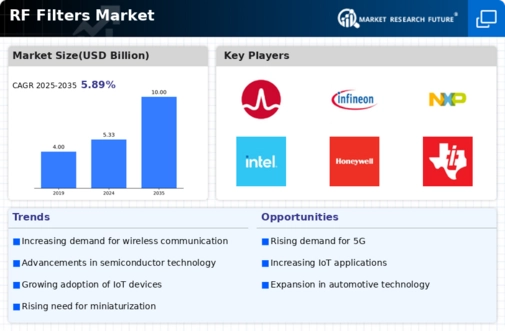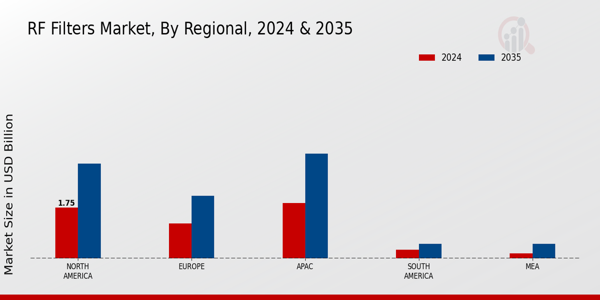Market Analysis
In-depth Analysis of RF Filters Market Industry Landscape
RF filters stand as indispensable foundational technologies essential for the efficient functioning of modern systems that demand top-notch RF performance. These cutting-edge systems encompass various spheres like autonomous vehicles, telemedicine, smart infrastructure, and other interconnected applications. In the realm of the Internet of Things (IoT), pivotal wireless technologies like mobile phones and fitness trackers rely on radio waves to transmit essential data. At the core of this wireless communication lie miniature yet specialized sensors known as RF filters, pivotal in both transmitting and receiving data.
With the burgeoning rise of wireless communication technologies, the radio frequencies utilized for data transmission have become increasingly crowded. This rapid expansion has led to the imperative need for robust RF filters that possess the capability to intelligently fine-tune bandwidths. These specialized filters, often referred to as tunable RF filters, possess the remarkable ability to automatically adjust bandwidths, effectively eliminating unwanted radio signals. This adaptability and intelligence make them an indispensable asset in handling the intricacies of modern wireless communication.
Filters, especially tunable RF filters, play an intrinsic role in wireless communication, a foundational component of the IoT technology framework. They serve as a critical element within radio frequency transceivers, essentially facilitating the seamless transmission and reception of data within wireless communication networks.
The significance of RF filters, particularly tunable RF filters, cannot be overstated in the realm of modern wireless communication. They are not only instrumental in optimizing the efficiency of wireless data transmission but also serve as a fundamental building block for the proliferation of IoT technologies, facilitating the seamless exchange of information in our interconnected world.
Tunable RF filters represent a remarkable advancement in wireless communication technology, enabling more efficient and adaptive handling of the growing demands placed on radio frequency bands. With the ever-increasing use of wireless devices, such as smartphones, IoT devices, and various interconnected systems, the radio spectrum has become increasingly crowded. This congestion leads to interference and signal degradation, impacting the overall performance of wireless communication systems.
Tunable RF filters address these challenges by dynamically adjusting the bandwidth and frequency ranges, ensuring that only the desired signals pass through while blocking out unwanted interference. Their adaptability is crucial in managing the complex and congested radio frequency environment, optimizing signal quality and enhancing overall network performance. By intelligently filtering signals, these advanced filters contribute significantly to the reliability and efficiency of wireless communication systems, allowing seamless data transmission and reception.
Moreover, the emergence of tunable RF filters has opened new avenues for innovation in various industries. These filters are not only crucial for improving wireless communication networks but also play a pivotal role in cutting-edge technologies like driverless vehicles, remote healthcare (telemedicine), smart infrastructure (smart cities), and other interconnected applications. Their ability to fine-tune frequencies and mitigate interference is particularly advantageous in these sectors where reliable and robust data transmission is paramount.
As technological advancements continue to evolve, the demand for tunable RF filters is expected to rise significantly. Their adaptability, precision, and efficiency in managing complex radio frequency environments position them as essential components for future wireless communication systems. These filters will continue to play a pivotal role in enhancing connectivity, enabling seamless communication between devices, and driving innovation across various industries, ultimately shaping the landscape of modern wireless technologies.








Leave a Comment